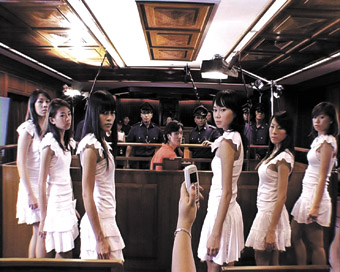mental karaoke
christine collins opens her eyes to the bohemian rhapsody project

Ho Tzu Nyen, The Bohemian Rhapsody Project
QUEEN’S ICONIC BOHEMIAN RHAPSODY HAS BEEN APPROPRIATED AND PARODIED BEFORE (THE COMIC STRIP PRESENTS; BAD NEWS BAND’S VERSION IS A PERSONAL FAVOURITE), AND I WOULD HAVE BEEN DISAPPOINTED HAD IT NOT BEEN USED OR MISUSED WELL IN THE BOHEMIAN RHAPSODY PROJECT. FORTUNATELY, IT HAS BEEN SAFE IN THE HANDS OF SINGAPORE’S HO TZU NYEN, WHO ADOPTS THE PIECE AS A KIND OF ‘READYMADE’ FRAMEWORK FOR THIS ARTWORK.
Ho’s Bohemian Rhapsody Project, created for the 2006 Singapore Biennale, is a film set in the Supreme Court of Singapore, which takes its spoken dialogue entirely from the lyrics of the song. The context is a courtroom trial and the characters are the accused, wearing Guantanamo-orange suits and the judge in traditional court garb, along with the police, jury and the public and, although not generally present in the courtroom, a chorus of girls in white (angels perhaps). Some of the lyrics are spoken as dialogue by the accused and some by the judge, other lyrics are sung by the chorus of girls and the clip includes an intrusive guitar solo. At one point, humorously, the melody comes from a ringtone on a mobile phone answered by the mother of the defendant.
The film changes scenes, style and pace, opening by entering through the light corridors of the building then changing between the courtroom, the grainy painterly judgement scene, and the rock clip/nightclub lit guitar solo. These changes are reminiscent of the original Bohemian Rhapsody, which unconventionally meshed and moved between musical styles (a cappella and glam rock), settings and outfits, giving Ho’s work a similar quality to what was engaging in the original.
The actor playing the accused also transforms as the film progresses. This might be interpreted as a trope alluding to the fact that a multitude of different peoples are subjected to a singular monolithic system of justice. Certainly the work can be seen as a comment on Singapore’s justice system and contentious use of capital punishment and the death penalty. There are, however, other layers. Ho has used footage from the auditions for the main character. For Ho, the defendant’s is the only role in a courtroom which changes. The audition and subsequent judgement by the director conflate with the theme of legal judgement: of the individual defendant in the court and, Ho suggests, with spiritual judgement, as the judge turns into a cardinal out of Velazquez (Portrait of Pope Innocent X, 1650) and Francis Bacon (Head VI, 1948). This might also be considered, as the catalogue essay indicates, a metaphor for aesthetic judgement, whereby the crime at the centre of the film is the double death of painting and cinema.
The film further explores the mechanics of the media by documenting its own production as the apparatus of the film’s own making (cameras, microphones, crew, lighting) are folded into the film itself. This film-within-a-film quality, the theatricality of the piece, along with the adoption of a pop-culture framework, alludes to the theatrical nature of the courtroom as it is presented in the media and popular culture. Further, it suggests the insertion of the media into the justice system.
Importantly, this work is also the remake of a music clip and Bohemian Rhapsody, for me, conjures up Sunday afternoons in the 70s watching Countdown and being perplexed (and impressed) by this unconventional music which crashed together musical styles, presented unfathomable lyrics and was incongruous with the rest of the pop music in the charts, which it dominated for weeks. I was reminded of its iconic status, when living in London, as Britain was mourning Freddie Mercury’s death and Bohemian Rhapsody seemed to be played constantly on the airwaves. I wondered what it meant for Ho or a Singaporean audience.
In the wall text which accompanied the work at the Singapore Biennale, Ho indicated that the adoption of a such a well known song meant that the narrative thread was spun by the spectators themselves, soliciting their memory of the music and lyrics, so that their “own projection could be overlaid onto the projected image.” Ho Tzu Nyen describes this as mental karaoke. Like the beguiling style and lyrics of the original, which are at once recognisable and incomprehensible (Mercury refused to explain them), the strength of this work rests with that “mental karaoke”, with both the familiarity and instability of its reference points, making the work impossible to fully apprehend but creating spaces for the audience to move between layers of interpretation.
Ho Tzu Nyen, The Bohemian Rhapsody Project, CACSA, Adelaide, June 1-July 8
RealTime issue #80 Aug-Sept 2007 pg. 54






